Alternative names Liberty Sandwich Food energy(per serving) 352 kcal (1474 kJ) | Created by George Newman Place of origin United States of America | |
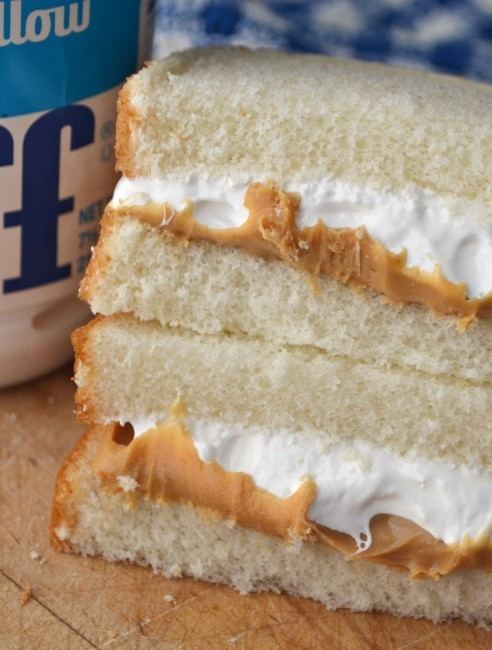 | ||
Similar Peanut butter, Marshmallow creme, Moon pie, S', Peanut butter cup | ||
A fluffernutter is a sandwich made with peanut butter and marshmallow fluff usually served on white bread. Variations of the sandwich include the substitution of wheat bread and the addition of various sweet, salty and savory ingredients. The term fluffernutter can also be used to describe other food items, primarily desserts, that incorporate peanut butter and marshmallow fluff.
Contents
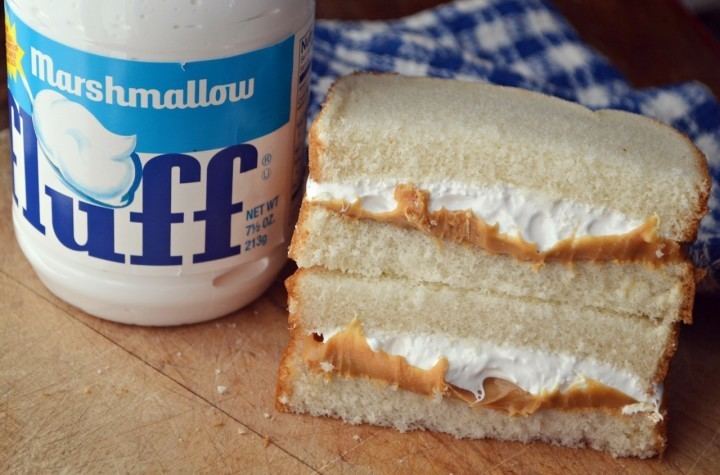
The sandwich was first created in the early twentieth century after marshmallow creme, a sweet marshmallow-like spread, was invented in Massachusetts. During World War I, a recipe for a peanut butter and marshmallow creme sandwich, the earliest known example of the sandwich, was published. The term “fluffernutter” was created by an advertising agency in 1960 as a more effective way to market the sandwich.
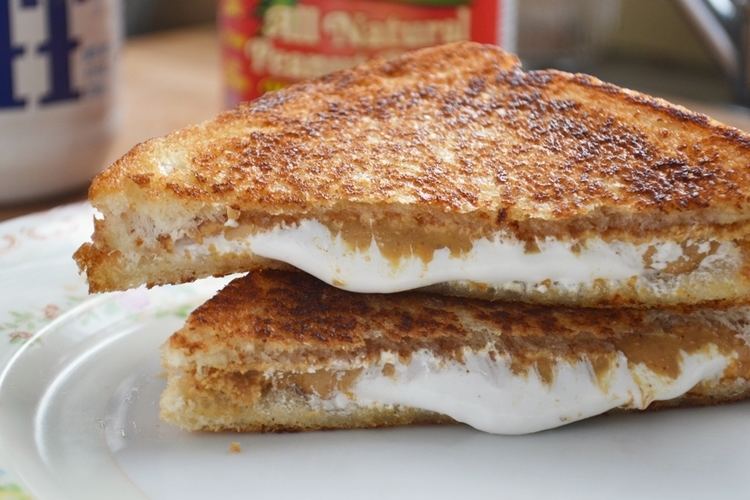
The sandwich is particularly popular in New England and has been proposed as the official state sandwich of Massachusetts.
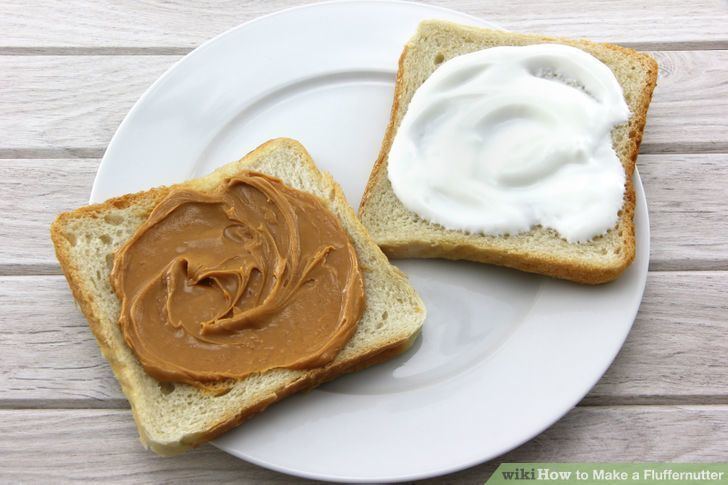
How to make a fluffernutter
Recipe and variations
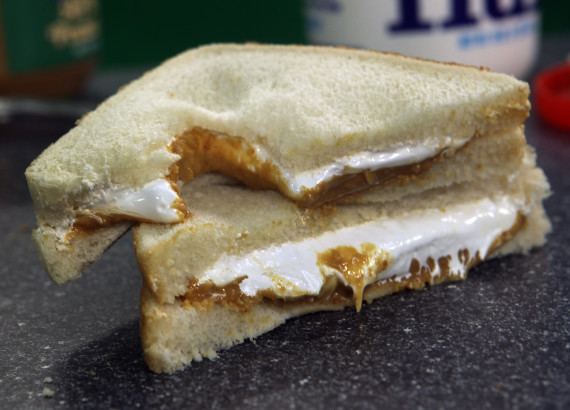
A fluffernutter is made by spreading peanut butter on a slice of bread, then spreading an equal amount of marshmallow fluff on another slice and finally combining them to form a sandwich. Variations of the recipe include wheat bread instead of white, Nutella hazelnut spread instead of or in addition to peanut butter, and the addition of sweet ingredients like bananas or savory and salty ingredients like bacon. The Fluffernutter itself is often seen as a variation on the peanut butter and jelly sandwich. Though often seen as a food for children, the Fluffernutter recipe has been adapted to appeal to adult tastes. For example, a New York caterer serves a Fluffernutter hors d'oeuvre in a toasted ice cream cone with a spoon of peanut butter and torched marshmallow fluff on top.

The term fluffernutter has also been used to describe other foods that feature peanut butter and marshmallow fluff, including Fluffernutter cookies, bars and cupcakes. Durkee-Mower, the company that produces Marshmallow Fluff, a brand of marshmallow fluff, produces a cookbook that features recipes for Fluffernutter bars, frosting, pie and a shake. In 2006, Brigham's Ice Cream and Durkee-Mower introduced a Fluffernutter flavor, which featured peanut butter and Marshmallow Fluff in vanilla ice cream. Fluffernutter was also the name of a candy briefly produced by the Boyer Brothers candy company beginning in 1969.
History
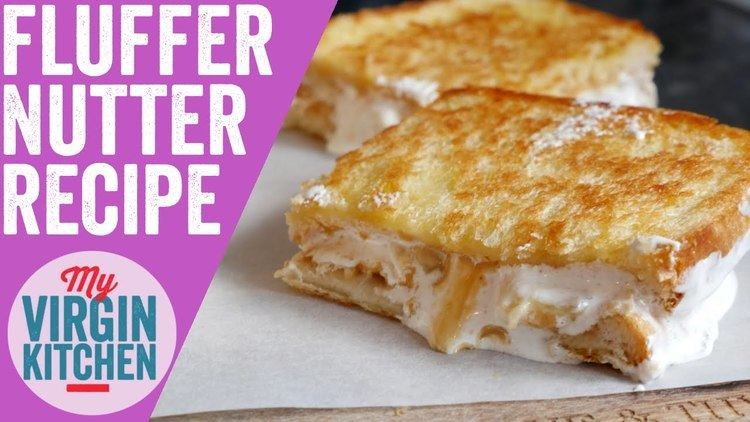
Marshmallow fluff, one of the two main ingredients of a Fluffernutter, was invented in the early 20th century. Archibald Query invented a creation he called Marshmallow Creme in Somerville, Massachusetts, in 1917, while Amory and Emma Curtis of Melrose, Massachusetts, invented Snowflake Marshmallow Creme in 1913. During World War I, Emma Curtis published a recipe for the Liberty Sandwich, which consisted of peanut butter and Snowflake Marshmallow Creme on oat or barley bread. The recipe was published in a promotional booklet sent to Curtis' customers in 1918 and may be the origin of the Fluffernutter sandwich. Earlier labels and booklets published by the Curtises suggested combining Snow Flake Marshmallow Creme with peanut butter or eating it on sandwiches with chopped nuts or olives.
Meanwhile, sugar shortages during World War I hurt sales of Archibald Query's Marshmallow Creme, so Query sold his recipe in 1920 to two men from Swampscott, Massachusetts, H. Allen Durkee and Fred L. Mower, who began distributing the product through their company, Durkee-Mower Inc. The pair renamed the product Toot Sweet Marshmallow Fluff, and Durkee-Mower continues to sell the product under the name Marshmallow Fluff. The sandwich made with peanut butter and marshmallow fluff continued to be eaten, but was not called a Fluffernutter until 1960, when an advertising firm Durkee-Mower hired created the term as a more effective way to market the sandwich. Fluffernutter is a registered trademark of Durkee-Mower, although the company's U.S. trademark registrations for the term cover only ice cream and printed recipes. In 2006, Durkee-Mower sued Williams-Sonoma Inc. in the United States District Court for the District of Massachusetts, alleging that Williams-Sonoma infringed on its trademark by selling a marshmallow and peanut butter chocolate-covered candy under the Fluffernutter name.
In June 2006, Massachusetts State Senator Jarrett Barrios gained national attention when he proposed legislation restricting the serving of Fluffernutter sandwiches in public schools. After Barrios learned that his son was served Fluffernutters on a daily basis at his Cambridge, Massachusetts, public elementary school, he created an amendment to a junk food bill that aimed to limit the serving of Fluffernutters in Massachusetts public schools to once a week. The proposal was criticized as an example of trivial and overly intrusive legislation, while Barrios' supporters pointed to concerns over the problem of childhood obesity. Among the people who defended the Fluffernutter at the time was Massachusetts State Representative Kathi-Anne Reinstein, whose district in Revere was close to Lynn, where Marshmallow Fluff is made. She claimed she planned to "fight to the death for Fluff" and supported legislation that would make the Fluffernutter the official state sandwich. The measure failed, and Reinstein tried again unsuccessfully in 2009. Supporters of the bill cited the sandwich's close association with childhood and Massachusetts.
In culture
The term fluffernutter has sometimes been used disparagingly to describe something that lacks substance and has minimal to no cultural value. On the other hand, some writers look on Fluffernutters and marshmallow fluff as a source of childhood nostalgia and regional pride.
The sandwich has close ties to New England, particularly to Somerville, Massachusetts, where Archibald Query invented Marshmallow Fluff, and to Lynn, Massachusetts, where Durkee-Mower has produced it for decades. Somerville holds an annual festival called What the Fluff? based around celebrating Marshmallow Fluff and Fluffernutter sandwiches. The festival incorporates music, visual art, games and a cooking contest based around Fluff and Fluffernutters. In 2011, NASA astronaut Richard Michael Linnehan, who was born in Lowell, Massachusetts, and ate a Fluffernutter while aboard the International Space Station, acted as one of the contest judges.
October 8 is National Fluffernutter Day.
